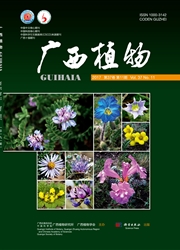

 中文摘要:
中文摘要:
该研究利用SSR分子标记,对肋果沙棘(Hippophaeneurocarpa)分布区北缘青海祁连地区5个自然居群进行分析,旨在了解小地理尺度下肋果沙棘北缘居群的遗传多样性和片段化分布居群的遗传结构,为肋果沙棘居群的资源保护提供了依据。采用6对微卫星引物对107个样本UNA进行扩增,共检测到27个等位变异,变幅为2~9个,平均每个位点有4.67个,平均观测杂合度(Ho)和期望杂合度(He)分别为0.142和0.230,Shannon信息指数(/)的变幅介于0.280~0.567之间,平均值为0.374,说明肋果沙棘北缘居群的遗传多样性较为丰富。遗传分化系数=0.483,分子方差分析(AM0VA)表明肋果沙棘有48.33%的变异存在于居群间,51.67%存在于居群内。对5个居群之间的遗传距离与地理距离做Mental检验,结果表明遗传距离与地理距离相关性不显著,对基因流检测发现居群间的iVm为0.328,推测遗传漂变是居群分化的关键因素之一。Structure分析把5个居群分为2组。LPGMA聚类分析表明5个居群聚为2个分支,其中居群ARX为单独的一支,与主坐标分析的结果一致。基于分布区北缘青海祁连肋果沙棘自然居群的遗传结构分析,建议应尽可能多地保护不同的地方居群。
 英文摘要:
英文摘要:
We analyzed five natural populations of Hippophae neurocarpa in the Qilian area of Qinghai Province with SSR molecular markers, in order to understand the genetic diversity of the northern margin populations of H. neurocar?pa on the small geographic scales and the genetic structure of the populations which distribute fragmentally, and to pro?vide reference for resource protection of H. neurocarpa populations. We used six microsatellite primers to amplify the DNA of 107 samples and detected 27 alleles, with the range of 2-9 and a mean value of 4.67 per locus. The average obser^red heterozygosity (Ho) and expected heterozygosity (He) of H. neurocarpa populations was 0.142 and 0.230 re?spectively ,and the range Shannon information index (I) wras between 0.280-0.567 with a average value of 0.374. The results showed that the genetic diversity of the northern margin populations of H. neurocarpa was abundant. The coeffi?cient of genetic differentiation (Fst) was 0.483. Molecular variance analysis (AMOVA) indicated that 48.33% of the variation existed among the populations, and 51.67% existed within the populations. No significant correlation between genetic distance and geographic distance was detected by Mental test and the detection of gene flow found that Nm was only 0.328 among populations. These results suggested that genetic drift wras one of the key factors for the differentia?tion of populations. The 5 populations wrere divided into 2 groups based on the structure analysis. UPGMA clustering showed that the 5 populations were clustered into 2 branches, one of which was AtlX, which was consistent with the results of the principal coordinate analysis. According to the analysis of the genetic structure, it is suggested to protect populations in situ as many as possible.
 同期刊论文项目
同期刊论文项目
 同项目期刊论文
同项目期刊论文
 期刊信息
期刊信息
